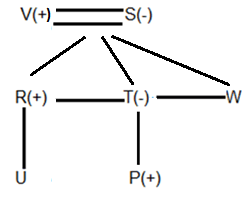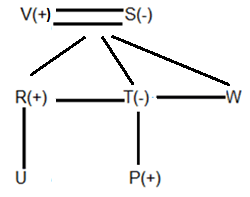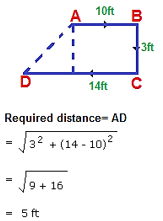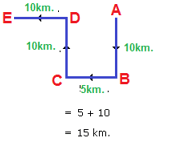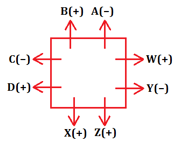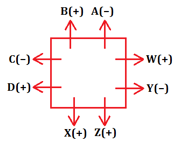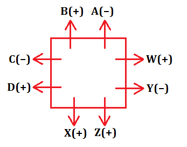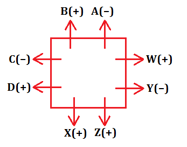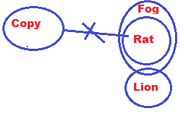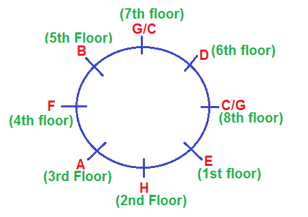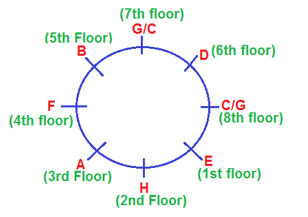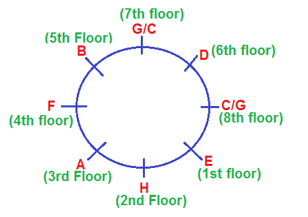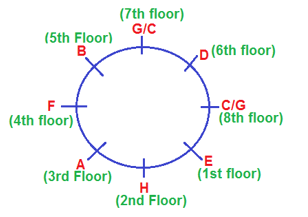NIACL Mock Test - 3 - Insurance MCQ
30 Questions MCQ Test NIACL (New India Insurance) Mock Test Series 2025 - NIACL Mock Test - 3
The following questions are based on the five three – digit numbers given below:
862 359 543 618 467
Q. If 3 is added to the second digit of each of the numbers how many numbers thus formed will be divisible by three?
The following questions are based on the five three – digit numbers given below:
862 359 543 618 467
Q. If all the digits in each of the numbers are arranged in descending order within the number, which of the following will be the highest number in the new arrangement of numbers ?
The following questions are based on the five three – digit numbers given below:
862 359 543 618 467
Q, If 3 is added to the first digit and 1 is added to the last digit of each of the numbers then which of the following numbers will be the second highest number
862 359 543 618 467
Q, If 3 is added to the first digit and 1 is added to the last digit of each of the numbers then which of the following numbers will be the second highest number
The following questions are based on the five three – digit numbers given below:
862 359 543 618 467
Q. What will be the resultant number if the second digit of the second lowest number is divided by the third digit of the highest number?
The following questions are based on the five three – digit numbers given below:
862 359 543 618 467
Q. If in each number the first and the third digits are interchanged then which will be the highest number?
Study the following information carefully to answer the given questions.
Eight people A, B, C, D, E, F, G and H are sitting in a straight line with equal distances between each other, but not necessarily in the same order. Some of them are facing north and some of them are facing south.
A sit at one of the extreme ends of the line. Only three people sit between A and G. E sits exactly between A and G.
H sits third to the right of E. B is an immediate neighbour of H and faces south. C sits second to the right of F. C is not an immediate neighbour of G.
Immediate neighbour of G face opposite directions (i.e. if one neighbour faces North then the other neighbour faces south and Vice-Versa)
A and D face the same direction as E (i.e. if E faces north then A and D also face North and Vice-Versa). Both the immediate neighbors of E face south.
Q. In the given arrangement, if another two people come and sit to the immediate left of E, how many people will sit between F and C?
Study the following information carefully to answer the given questions.
Eight people A, B, C, D, E, F, G and H are sitting in a straight line with equal distances between each other, but not necessarily in the same order. Some of them are facing north and some of them are facing south.
A sit at one of the extreme ends of the line. Only three people sit between A and G. E sits exactly between A and G.
H sits third to the right of E. B is an immediate neighbour of H and faces south. C sits second to the right of F. C is not an immediate neighbour of G.
Immediate neighbour of G face opposite directions (i.e. if one neighbour faces North then the other neighbour faces south and Vice-Versa)
A and D face the same direction as E (i.e. if E faces north then A and D also face North and Vice-Versa). Both the immediate neighbors of E face south.
Q. Who amongst the following sits third to the right of F?
Study the following information carefully to answer the given questions.
Eight people A, B, C, D, E, F, G and H are sitting in a straight line with equal distances between each other, but not necessarily in the same order. Some of them are facing north and some of them are facing south.
A sit at one of the extreme ends of the line. Only three people sit between A and G. E sits exactly between A and G.
H sits third to the right of E. B is an immediate neighbour of H and faces south. C sits second to the right of F. C is not an immediate neighbour of G.
Immediate neighbour of G face opposite directions (i.e. if one neighbour faces North then the other neighbour faces south and Vice-Versa)
A and D face the same direction as E (i.e. if E faces north then A and D also face North and Vice-Versa). Both the immediate neighbors of E face south.
Q. At least how many people face north as per the given arrangement?
Study the following information carefully to answer the given questions.
Eight people A, B, C, D, E, F, G and H are sitting in a straight line with equal distances between each other, but not necessarily in the same order. Some of them are facing north and some of them are facing south.
A sit at one of the extreme ends of the line. Only three people sit between A and G. E sits exactly between A and G.
H sits third to the right of E. B is an immediate neighbour of H and faces south. C sits second to the right of F. C is not an immediate neighbour of G.
Immediate neighbour of G face opposite directions (i.e. if one neighbour faces North then the other neighbour faces south and Vice-Versa)
A and D face the same direction as E (i.e. if E faces north then A and D also face North and Vice-Versa). Both the immediate neighbors of E face south.
Q. Four of the following five are alike in a certain way based upon their seating arrangement and so form a group. Which of the following does not belong to the group?
Study the following information carefully to answer the given questions.
Eight people A, B, C, D, E, F, G and H are sitting in a straight line with equal distances between each other, but not necessarily in the same order. Some of them are facing north and some of them are facing south.
A sit at one of the extreme ends of the line. Only three people sit between A and G. E sits exactly between A and G.
H sits third to the right of E. B is an immediate neighbour of H and faces south. C sits second to the right of F. C is not an immediate neighbour of G.
Immediate neighbour of G face opposite directions (i.e. if one neighbour faces North then the other neighbour faces south and Vice-Versa)
A and D face the same direction as E (i.e. if E faces north then A and D also face North and Vice-Versa). Both the immediate neighbors of E face south.
Q. Who amongst the following sits at the extreme end of the row?
Read the following information carefully and answer the questions given below:
P is son of U’s father’s sister. R is son of S. Who is the mother of T and grandmother of U. V is the father of W and maternal grandfather of P. S is wife of V. T is sister of R. W is unmarried.
Q. How is P related to S?
Read the following information carefully and answer the questions given below:
P is son of U’s father’s sister. R is son of S. Who is the mother of T and grandmother of U. V is the father of W and maternal grandfather of P. S is wife of V. T is sister of R. W is unmarried.
Q. How is R related to P?
Read the following information carefully and answer the questions given below:
P is son of U’s father’s sister. R is son of S. Who is the mother of T and grandmother of U. V is the father of W and maternal grandfather of P. S is wife of V. T is sister of R. W is unmarried.
Q. How is T related to W?
X walked from A to B in the East 10 feet. Then she turned to the right and walked 3 feet to C. Again she turned to the right and walked 14 feet to D. How far is she from A (considering shortest route)?
X left home and cycled 10 km towards South from A to B, then turned right and cycled 5 km to C and then again turned right and cycled 10 km to D. After this he turned left and cycled 10 km to E. How many kilometers will he have to cycle to reach his home straight?
Study the following information carefully and answer the given questions.
A, Z, B, C, D, W, X and Y are eight friends sitting around a square table, two on each side. All of them are facing away from the centre and each sits opposite to another. There are three female members and no two females are seated next to one another.
X sits between D and Z. Y is a female member who sits second to the left of X. Z is not a female member but sits opposite A, who is a female. C sits third to the left of W and is not male member. C and D are immediate neighbors of each other.
Q. Who among the following sits on the immediate left of Z?
Study the following information carefully and answer the given questions.
A, Z, B, C, D, W, X and Y are eight friends sitting around a square table, two on each side. All of them are facing away from the centre and each sits opposite to another. There are three female members and no two females are seated next to one another.
X sits between D and Z. Y is a female member who sits second to the left of X. Z is not a female member but sits opposite A, who is a female. C sits third to the left of W and is not male member. C and D are immediate neighbors of each other.
Q. Which of the following statements is true about W and X?
Study the following information carefully and answer the given questions.
A, Z, B, C, D, W, X and Y are eight friends sitting around a square table, two on each side. All of them are facing away from the centre and each sits opposite to another. There are three female members and no two females are seated next to one another.
X sits between D and Z. Y is a female member who sits second to the left of X. Z is not a female member but sits opposite A, who is a female. C sits third to the left of W and is not male member. C and D are immediate neighbors of each other.
Q. Which among the following groups includes only females?
Study the following information carefully and answer the given questions.
A, Z, B, C, D, W, X and Y are eight friends sitting around a square table, two on each side. All of them are facing away from the centre and each sits opposite to another. There are three female members and no two females are seated next to one another.
X sits between D and Z. Y is a female member who sits second to the left of X. Z is not a female member but sits opposite A, who is a female. C sits third to the left of W and is not male member. C and D are immediate neighbors of each other.
Q. Who among the following sits exactly between B and W, when counted from the right of B?
Study the following information carefully and answer the given questions.
A, Z, B, C, D, W, X and Y are eight friends sitting around a square table, two on each side. All of them are facing away from the centre and each sits opposite to another. There are three female members and no two females are seated next to one another.
X sits between D and Z. Y is a female member who sits second to the left of X. Z is not a female member but sits opposite A, who is a female. C sits third to the left of W and is not male member. C and D are immediate neighbors of each other.
Q. How many persons sit between C and Y?
Some statements are given followed by some conclusions. You have to consider the statements to be true even if they seem to be at variance from commonly known facts. You have to decide which of the following conclusions follow from the given statements:
Statements: –
No copy is rat. All rats are fog. Some fog are lion.
Conclusions:
I. No copy is lion
II. No fog is a rat.
III. Some fog is rat is a possibility.
IV. At least some lions are copy.
Some statements are given followed by some conclusions. You have to consider the statements to be true even if they seem to be at variance from commonly known facts. You have to decide which of the following conclusions follow from the given statements:
Statements:
Some motor are clutch. No clutch is Gear. All screw are Gears.
Conclusions:
I. Some screw are clutch
II. Some motor are Gear
III. Some screws are motor
Some statements are given followed by some conclusions. You have to consider the statements to be true even if they seem to be at variance from commonly known facts. You have to decide which of the following conclusions follow from the given statements:
Statement:
No ram is roy. All roy are pooja. Some raj are pooja.
Conclusions:
I. All raj being ram is a possibility.
II. All pooja being raj is a possibility.
Some statements are given followed by some conclusions. You have to consider the statements to be true even if they seem to be at variance from commonly known facts. You have to decide which of the following conclusions follow from the given statements:
Statements:
No phone is Pen. All Pens are copy. Some buckets are phones. Some copy are buckets.
Conclusions:
I. No phone is copy.
II. All buckets being Pens is a possibility
III. Some copy are phones
IV. Some buckets are Pens.
Some statements are given followed by some conclusions. You have to consider the statements to be true even if they seem to be at variance from commonly known facts. You have to decide which of the following conclusions follow from the given statements:
Statements:
All bed are fan. No fan is bun. Some buns are roofs. Some tube are fan.
Conclusions:
I. All tube being buns is a possibility
II. All tube being roof is a possibility
III. Some tube are not buns.
IV. No bed is bun
Study the following information carefully to answer the given questions
Eight friends A, B, C, D, E, F, G and H are sitting around a circular table facing the centre. All of them buy a house in different floor viz. 1st, 2nd, 3rd, 4th, 5th, 6th, 7th and 8th but not necessarily in the same order. F is third to the right of D, who does not have house in 7th or 8th floor. The one who have house in 6th floor is an immediate neighbour of G and C. The one who have house in 7th floor is second to the left of F, who have house in 4th floor. The one who have house in 8th floor is opposite to F. H is not an immediate neighbour of either C or F but is third to the right of B. The persons who have house in 6th and 3rd floor sit opposite to each other. H has a house in 2nd floor. The one who have a house in 7th floor sits third to the left of the one who have house in 3rd floor. The one who have house in 1st floor and the one who have house in 8th floor are immediate neighbors. A does not have house in 1st floor. E is second to the right of A, who is an immediate neighbour of F and H.
Q. Who among the following have house in 5th floor?
Study the following information carefully to answer the given questions
Eight friends A, B, C, D, E, F, G and H are sitting around a circular table facing the centre. All of them buy a house in different floor viz. 1st, 2nd, 3rd, 4th, 5th, 6th, 7th and 8th but not necessarily in the same order. F is third to the right of D, who does not have house in 7th or 8th floor. The one who have house in 6th floor is an immediate neighbour of G and C. The one who have house in 7th floor is second to the left of F, who have house in 4th floor. The one who have house in 8th floor is opposite to F. H is not an immediate neighbour of either C or F but is third to the right of B. The persons who have house in 6th and 3rd floor sit opposite to each other. H has a house in 2nd floor. The one who have a house in 7th floor sits third to the left of the one who have house in 3rd floor. The one who have house in 1st floor and the one who have house in 8th floor are immediate neighbors. A does not have house in 1st floor. E is second to the right of A, who is an immediate neighbour of F and H.
Q. Which among the following is the floor of C’s house?
Study the following information carefully to answer the given questions
Eight friends A, B, C, D, E, F, G and H are sitting around a circular table facing the centre. All of them buy a house in different floor viz. 1st, 2nd, 3rd, 4th, 5th, 6th, 7th and 8th but not necessarily in the same order. F is third to the right of D, who does not have house in 7th or 8th floor. The one who have house in 6th floor is an immediate neighbour of G and C. The one who have house in 7th floor is second to the left of F, who have house in 4th floor. The one who have house in 8th floor is opposite to F. H is not an immediate neighbour of either C or F but is third to the right of B. The persons who have house in 6th and 3rd floor sit opposite to each other. H has a house in 2nd floor. The one who have a house in 7th floor sits third to the left of the one who have house in 3rd floor. The one who have house in 1st floor and the one who have house in 8th floor are immediate neighbors. A does not have house in 1st floor. E is second to the right of A, who is an immediate neighbour of F and H.
Q. If G is to the immediate left of B, then who among the following sits between D and E, when counted from the left of D?
Study the following information carefully to answer the given questions
Eight friends A, B, C, D, E, F, G and H are sitting around a circular table facing the centre. All of them buy a house in different floor viz. 1st, 2nd, 3rd, 4th, 5th, 6th, 7th and 8th but not necessarily in the same order. F is third to the right of D, who does not have house in 7th or 8th floor. The one who have house in 6th floor is an immediate neighbour of G and C. The one who have house in 7th floor is second to the left of F, who have house in 4th floor. The one who have house in 8th floor is opposite to F. H is not an immediate neighbour of either C or F but is third to the right of B. The persons who have house in 6th and 3rd floor sit opposite to each other. H has a house in 2nd floor. The one who have a house in 7th floor sits third to the left of the one who have house in 3rd floor. The one who have house in 1st floor and the one who have house in 8th floor are immediate neighbors. A does not have house in 1st floor. E is second to the right of A, who is an immediate neighbour of F and H.
Q. Who among the following sits on the second to the right of F?
Study the following information carefully to answer the given questions
Eight friends A, B, C, D, E, F, G and H are sitting around a circular table facing the centre. All of them buy a house in different floor viz. 1st, 2nd, 3rd, 4th, 5th, 6th, 7th and 8th but not necessarily in the same order. F is third to the right of D, who does not have house in 7th or 8th floor. The one who have house in 6th floor is an immediate neighbour of G and C. The one who have house in 7th floor is second to the left of F, who have house in 4th floor. The one who have house in 8th floor is opposite to F. H is not an immediate neighbour of either C or F but is third to the right of B. The persons who have house in 6th and 3rd floor sit opposite to each other. H has a house in 2nd floor. The one who have a house in 7th floor sits third to the left of the one who have house in 3rd floor. The one who have house in 1st floor and the one who have house in 8th floor are immediate neighbors. A does not have house in 1st floor. E is second to the right of A, who is an immediate neighbour of F and H.
Q. Which of the following is true?








